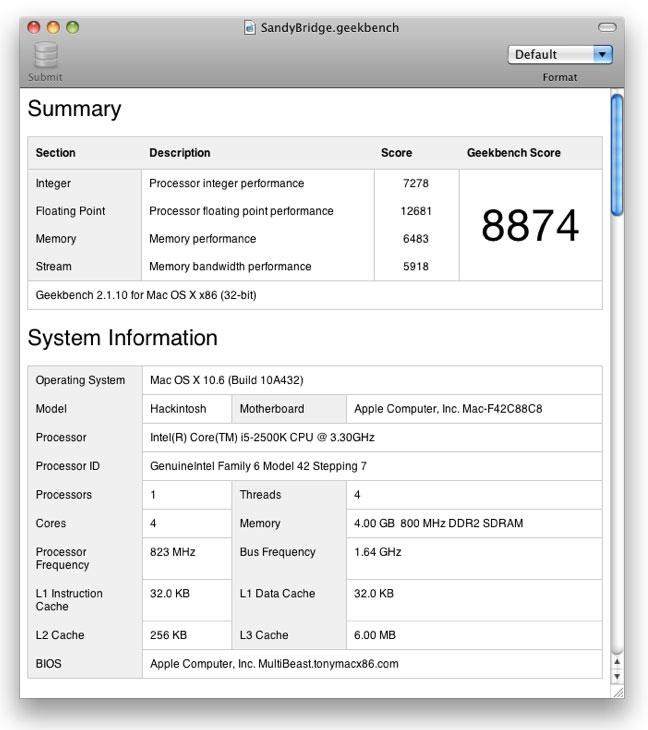Apple's Mac OS X hacked to run on Intel's new Sandy Bridge processors
The Consumer Electronics Show this week marks the official introduction of Intel's newly redesigned processors, which are the first to combine visual and 3D graphics technology along with microprocessors on the same chip. The product line, codenamed "Sandy Bridge," features newly architected Intel HD Graphics on each 32nm die for significant performance improvements over previous generation graphics.
While Intel's latest family of chips, featuring a major redesign, will inevitably arrive in future Macs from Apple, hackers this week wasted no time to install Mac OS X on a Sandy Bridge processor. As noted by Engadget, Mac OS X 10.6 Snow Leopard was installed onto a "Hackintosh" machine running the Intel Core i5-2500K CPU, with a clock speed of 3.30GHz.
The system, running Snow Leopard, achieved a Geekbench Score of 8874 and an Xbench score of 282.40, boosted in part by 6MB of L3 cache in the Sandy Bridge chip. The feat was achieved by utilizing a patched kernel, and the process was detailed by the blog tonymacx86 after Intel lifted their non-disclosure agreement for those with early access to the new processors.
"Until Apple uses these CPUs, it's a bit of a science experiment, as you'll need to use a 'patched' non-standard Darwin kernel in order to boot the system," the blog reads.
While Intel is prepared to officially unveil its second-generation Core processor family during CES Press Day on Wednesday, the company did issue a press release earlier this week touting some of the features of its newly redesigned line of chips. The chipmaker said more than 500 desktop and laptop PCs are expected from all major computer manufacturers throughout 2011.
"The new 2nd Generation Intel Core processors represent the biggest advance in computing performance and capabilities over any other previous generation," said Mooly Eden, vice president and general manager, PC Client Group, Intel. "The built-in visual capabilities enabled by these new processors are stunning. This combined with improved adaptive performance will revolutionize the PC experience in a way that is obvious for every user to see and appreciate – visibly smarter performance."
New features include Intel Insider, Intel Quick Sync Video, and a new version of the company's award-winning Intel Wireless Display (WiDi), which now adds 1080p HD and content protection for those wishing to beam premium HD content from their laptop screen to their TV. The company also revealed arrangements with CinemaNow, Dixons Retail plc, Hungama Digital Media Entertainment, Image Entertainment, Sonic Solutions, and Warner Bros. Digital Distribution.
In December, a rumor claimed that Apple would release new MacBooks in 2011 that will rely on Intel's Sandy Bridge processor family, which could mean that Nvidia graphics solutions will not be included in at least some models 13 inches and under. It has been suggested that MacBook models with screen sizes 13 inches and under will have Intel Sandy Bridge-only graphics, while Apple's larger, higher-end MacBooks with screen sizes of 15 and 17 inches will allegedly rely on GPUs from AMD.
Starting in 2010 with its Arrandale processors, Intel began building in the major northbridge chipset memory controller components to its chips. The architectural changes in Arrandale, along with a lawsuit, forced Nvidia to halt the development of future chipsets.
 Sam Oliver
Sam Oliver











 William Gallagher
William Gallagher
 Wesley Hilliard
Wesley Hilliard
 Andrew Orr
Andrew Orr



 Amber Neely
Amber Neely







